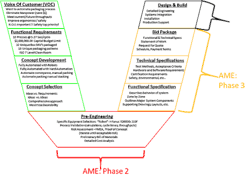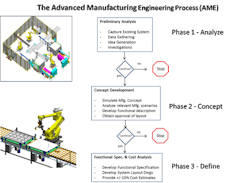Craig Salvalaggio, vice president of engineering at Applied Manufacturing Technologies in Detroit, will be giving a presentation on the key factors to consider before deploying automation, as part of the Is Automation Right for Your Company? session on April 4 from 10 am to noon at Automate 2017 in Chicago. Contact him at [email protected].
With so many automation choices, the path can be complex. First, ask whether automation is right for your company. If so, then how do you get started?
As technologies advance and production costs climb, automation continues to permeate new industries at a growing pace. While the net effect is positive, it seems that for every success story there is a project that failed.
Automation is everywhere, but often systems don’t deliver and or are decommissioned, and some projects’ budgets or schedules explode. The last thing you want is a robotic system that has been decommissioned.
The five key areas you’ll need to set up in logical order when approaching automation are:
- top reasons to consider automation
- top business requirements to take into consideration
- process requirements
- appropriate level of automation and partner selection
- empirical phased approach to automation.
Economic drivers that are fueling the trends in automation include:
- technology improvements
- new market segments with proven applications
- re-shoring growth expansion
- increasing energy-efficient materials
- global competition and increasing quality
- growing consumer markets
- consumer markets growing
- shrinking product lifecycles
- workplace safety.
Should you automate?
Let’s face it, robots are cool, and there are thousands of successfully automated systems in operation around the world. Everyone should automate. Or should they?
The truth is, not every process is a good candidate for automation. There are many reasons why automation may be the right answer to a problem—safety, cost, ergonomics, quality, throughput. Oftentimes, however upon careful analysis, automation is not the best solution for solving the underlying problems. Many companies focus on getting you to automate rather than doing what is best for you. This is where you need to look at your organization and talents within for frank and unbiased input on your initiative.
So, where do your start? If you’re coming from a large heavily automated industry such as automotive, where there is a combination of years of experience in deploying thousands of robots with dedicated teams of people who help make these decisions, you already know what to do. These processes have been around for many years. Companies in these industries reduce manufacturing and technology risk by performing testing in technical centers, and they standardized right down to the logic and components on the floor.
As automation and industrial robots shift to new industries, applications, and less mature processes, there is more education that needs to take place. Remember many companies looking to automate have never done this.
You may want to automate because you want to increase throughput, quality and safety, all while reducing labor costs and footprint. You may want to produce more, with less people, in a smaller footprint, all while increasing efficiency.
Sounds easy, right? The difficult part is tying reasons to business requirements with assignable metrics that must be met as part of the project. Business requirements include schedule and project milestones; engineering and equipment lead time; available funding, or budget; and payback period, or return on investment.
Business requirements
This is where you have measureable metrics that will tie into the reasons for automating in the first place and be a part of the project scope.
Next, are the system attributes and identifying which ones are important to your manufacturing floor. These should all be in the back of your mind during your initial approach to automation, but don’t let the engineer in you get tied up in system attributes prior to the larger project drivers. This is what you design into the automation as a part of your process. Think about:
- scalability
- flexibility
- facility changes
- manufacturing risk (POP)
- technology risk (POP)
- compatibility
- packing materials design change
- material flow
- recurring schedule and costs
- product requalification
- waste bi-product or material disposal.
Compromising or shortcutting this inclusion of system attributes can lead to an unsuccessful project, which results in safety violations, equipment placement or manufacturing-floor alignment, process and application fail points, software logic errors and increased labor costs.
These are all costly examples of what you get when you compromise on following a process that keeps your goals and metrics tied to your automation project.
Process
Most companies don’t have a good handle on their processes. Assembly-line operators often understand their job tasks differently from their work instructions. They do it because that’s how the materials come in or it makes their jobs easier.
Without deep analysis, the information never makes it back to the manufacturing team and ultimately can lead to a missed step in the design process.
Start by walking the floor and asking questions. Then map it, task by task, for product, people and data. You need to know how materials come in and how they leave; identify inputs and outputs.
There are multiple tools—for example, process flow charts (inputs/outputs); value stream mapping (VA/NVA/waste); spaghetti (non-linear tracing). Pick one that works for you. If anything, this will allow you to review all of your operations and their efficiencies.
Break processes into tasks: Pick Part A; check Feature B; place into machine, noting orientation. Tasks can be performed many ways: Load Part A into Machine B with an operator or with a robot. This may seem basic, but remember your picking the best solution for your entire process.
A large product mix might require different (flexible) automation vs. a small mix. There are many ways to build subcomponent assembly into the automation or batch-build off-line, depending on the volume, complexity and process. There are many processes such as welding, machining, stamping, painting and dispensing that lend themselves to automation, but these are process-intensive and took years of development and products designed specifically for these applications. Don’t reinvent the wheel with unproven processes, or you could end up in the failed automation category.
Here’s a list of things to consider:
- product mix: how many final assemblies?
- number of subcomponents per final assembly
- number of processes per final assembly
- number of operators
- type of equipment
- cycle time
- current system or line throughput (baseline)
- current quality numbers (process capability, process performance, scrap, rework)
- footprint.
ALSO READ: The future of manufacturing: Only the innovative need apply
Level of automation
Many types of applications have been automated for years. The bugs have been worked out, and the solutions are readily available from a variety of sources. In these cases, you can find companies that specialize in those solutions and get competitive offerings. Leverage the experts in these situations, and don’t try to reinvent the wheel. Many challenges are unique though, and there is no simple source for the best answer. If this is your situation, find a resource with a breadth of experience across industries, applications and suppliers. Mine their knowledge for the custom team and solution it’s going to take to solve your problem after reviewing the level of automation appropriate for your company. You then need to decide if you should self-integrate or go outside to an integrator or automation partner.
Ask yourself about the capabilities, time and resources, application experience and safety-design liabilities that the best automation solution should embrace, and make use of your in-house expertise; do not ignore or replace it. If you do decide that going outside for automation is the best decision for you, look for an integrator able to deliver these qualifying criteria:
- trust
- business stability
- proposal
- application experience
- engineering capabilities
- program management
- service and technical support
- spare parts
- safety
- training.
Approaching automation
If you look at the Advanced Manufacturing Engineering V approach to automation, the diagram would represent all phases of a project from business case and napkin sketch concept through completion (Figure 1).
Figure 1: The Advanced Manufacturing Engineering V approach’s diagram represents all phases of a project from business case and napkin sketch concept through completion.
If your manufacturing organization is new to automation, the process can be complex and overwhelming. Alternatively, some of you may have a very detailed process and automation team already developing standards and managing suppliers.
Let’s simplify the process. When it comes to making your final decision, the options you are considering should be the result of a structured empirical approach that has removed the guesswork out of what you can expect with any of your choices.
Every solution will yield results at some cost and with have caveats along with it. Conceiving, designing and implementing custom automation solutions are a science. It begins with gathering the right data, following a structured analysis and presenting multiple fact-based solutions.
The Advanced Manufacturing Engineering Process is a good place to start (Figure 2).
Figure 2: The Advanced Manufacturing Engineering Process is a good place to start.
Phase 1—Analyze: Engineers tend to focus on process requirements and can sometimes lose track of everything else that matters, meaning, why are we even doing the project? The process we just went through seeks to keep all of these things in mind. Start with the reasons that you care about, determine metrics, and make them quantifiable. Take a snapshot of what exists. Get out on the floor, map it, field-check it and collect data in all areas. Go back to what we just discussed and focus on the key areas and processes and look at metrics to determine what has priorities.
The preliminary analysis is all about data collection. You’ve already decided what’s important. Keep the top reasons in front, and review the attributes. Document all captured parameters, clearly state assumptions for unavailable parameters, reach accordance with your automation team and stakeholders, do some preliminary analysis with initial concepts and investigations, and assemble an automation team to start with brainstorming concepts.
Whiteboard the process. Look at material flow and product handling. Review available off-the-shelf technology. Capture every idea, including what it does, why it helps, and what investigation is required. Research supplier and automation partners to see what’s right for you.
Phase 2—Concept: If you’ve made it through Gate 1 and have the correct team and talent, take it to the next level with more realistically engineered ideas. Develop relevant simulation concepts based on actual sequence, throughput and floor space. If you can, do some early investigations on manufacturing concepts and then bring them to life with CAD and simulations tools for manufacturing relevance.
Phase 3—Design: Put together a functional spec. Define the system with functional and technical specifications, so you know what to expect with hardware and software, and multiple suppliers can deliver consistent quality. Review layout and costs estimates that you’ve already done some initial investigation on, so you already know the range of costs to be expected.
Continue Reading

Leaders relevant to this article:






